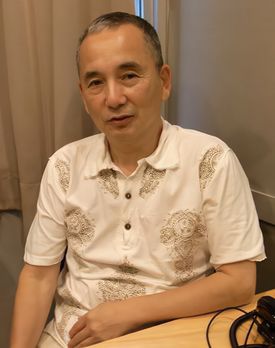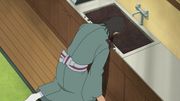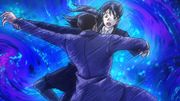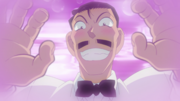Yoshio Urasawa
Yoshio Urasawa (浦沢 義雄 Urasawa Yoshio), born 21 January 1951[1], is a renowned Japanese screenplay writer from Tokyo[2]. He is known from his comical scenarios.
Contents
Biography
In his early life, Yoshio Urasawa studied under screenwriters Atsushi Yamatoya (大和屋 竺) and Seijun Suzuki (鈴木 清順). He then debuted in 1979 in the 68th episode of the anime Lupin the Third: Season 2 (ルパン三世 PARTII)[1][3].
He also showed his ability to write comedy from 1981 to 1993, in which he participated in the production of the entire Toei Fushigi Comedy Series (東映不思議コメディーシリーズ) as the screenplay[4]. Incidentally, he is the only person who was involved in the screenplay writing for the entire series, for which he has written more than 400 scripts. Apart from screenplay writing, Urasawa also composed several lyrics for background music in that series. Owing to this relation, Urasawa's later works contained similar styles with the works produced by Toei; examples would be his Sandaime wa Onyanko Ojosama?! (三代目はおニャン子お嬢さま?!).
During the 1980 period, he was also active under the alias "うらさわよしお", and wrote some scripts for the first season of Tales of the Unusual (世にも奇妙な物語) back then. From 1993 onwards, he was in charge of the anime Nintama Rantarō (忍たま乱太郎), whose duration lasted for roughly one fourth of a century, and Urasawa was responsible for 90% of the organizer/screenplay work, which was thus regarded as one of his representative works[5]. Other than the anime version, Urasawa even wrote scripts for the movies of that series in 2011. In 2003, he published his novel Tamago Osho (たまご和尚)[6], illustrated by Tamura Noboru (タムラノボル). Afterwards, starting July 2009, he began to write scripts for live-action drama, the TV Tokyo late-night programme, We Are Angels! NO ANGEL NO LUCK (俺たちは天使だ! NO ANGEL NO LUCK). After that, he concentrated on animation works and returned to the anime series Nintama Rantarō. He also wrote a script for a Crayon Shin-chan movie in 2013: Crayon Shin-chan: Very Tasty! B-class Gourmet Survival!! (クレヨンしんちゃん バカうまっ!B級グルメサバイバル!!)[7].
Style analysis
In late 2019, the Detective Conan anime production team invited Akatsuki Yamatoya (Urasawa's disciple) and Yoshio Urasawa into the anime for screenplay writing. As the director Yasuichiro Yamamoto claimed that both of them are "fast brush strokers", which produce screenplays rather quickly, they recruited them for (screenplay) stock accumulation[8].
Urasawa's contributions to Detective Conan are rather rebuttable due to the story style of his works, which consist mostly of comedies; evidently disobeys the classic Detective Conan story styles. As a result, most times when his script got the chance to be aired, it would obtain several trendings on different social media. A lot of fans do not fancy his scripts and find them insane[Note 1], as Urasawa usually writes some abstract scenes (see below). A typical example would be the Intrigue at Smile Village, in which he invented two characters, named Tango and Waltz, respectively, and they even had a scene dancing on top of the table, considering building their retirement home in space... Nevertheless, several cases written by him do reflect certain social status and issues and could be reluctantly considered meaningful, which befits the criteria of Shakai deduction (社会派推理). For example, The Idol Whose Smile Disappeared manifests the negative competition among the idol groups, which is highly coincide with the reality.
Urasawa's main style in his works must be comedy mystery (バカミステリー), which is quite pronounced as his forte is to progress plots in a hilarious manner. Apart from Shakai Detective Fiction, he has written Armchair Detective deduction for once, which is a form that is fairly rare in Detective Conan. Some elements from Honkaku deduction (本格派推理) also appeared in his Ballad of the Woman Who Loved Cake; and notably, his The Shopping Center in Love paid tribute to the renowned Sherlock Holmes short story Red-Headed League, written by Conan Doyle. In addition, the director Yasuichiro Yamamoto absolutely appreciates Urasawa's works; he even claimed in an interview that his scripts are "surrealism" and can create a sense of addiction[9]. This can also be seen in the staff team of Urasawa's episodes; Yamamoto served as the storyboard artist for some of them. Moreover, Yamamoto was the one who came up with the idea of "the victim drowned midst the red bean paste", he said, particularly that "innovative" devise reminded him of Wealthy Daughter Murder Case[10].
Scenarios written
Number of case scenarios written: 13 (13 episodes)
- The Tokyo Barls Collection (Episode 943)
- The Secret of the Insect Man (Episode 955)
- Follow Them! Detective Taxi (Episode 976)
- Intrigue at Smile Village (Episode 997)
- The Idol Whose Smile Disappeared (Episode 1010)
- Ballad of the Woman Who Loved Cake (Episode 1028)
- Bad Guys (Episode 1057)
- The Shopping Center in Love (Episode 1067)
- The Genius Restaurant (Episode 1089)
- The Four-Person Class Reunion (Episode 1119)
- The Detective Who Lost His Mind (Episode 1126)
- Follow Them! Detective Taxi 2 (Episode 1155)
- Follow Them! Detective Taxi 3 (Episode 1188)
Gallery
Some famous scenes created by him:
Other notable works
Anime
- Digimon: Screenplay
- Powerpuff Girls: Screenplay
- Crayon Shin-Chan: Screenplay
- Hello Kitty: Series composition
- Kamen Rider: Screenplay
- Lupin III: Screenplay
- Ranma ½: Screenplay
- Many other animes including Nintama Rantaro, Blue Dragon, and Osomatsu-kun etc.
See also
References
- 浦沢義雄 - Wikipedia
- Yoshio Urasawa - IMDb
- Yoshio Urasawa - Anime News Network
- Detective Conan Staff Listing
- ^ a b "「オペレッタ狸御殿 脚本家インタビュー 浦沢義雄」". 『宇宙船』Vol.118(2005年5月号): 85. May 1, 2005.
- ^ "豪快演義 2012「WRITER INTERVIEW_04 浦沢義雄」". 豪快演義: 86-87. 2012.
- ^ "「スーパー戦隊制作の裏舞台 浦沢義雄」". スーパー戦隊 Official Mook 20世紀: 32. August 9, 2018.
- ^ "「がんばれいわ!!ロボコン」". 『宇宙船』vol.169(SUMMER 2020.夏): 98-99. August 3, 2020.
- ^ NHK - 忍たま乱太郎
- ^ たまご和尚 - 浦沢義雄 (著)
- ^ クレヨンしんちゃん バカうまっ!B級グルメサバイバル!!
- ^ 『名探偵コナン』の挑戦 山本×米倉 対談
- ^ Animage 04/2021 山本×諏訪×寺島×米倉 月光編 対談
- ^ 高木啓明 - X
- ^ Note: In one of the interviews, Urasawa proclaimed he is totally aware that Detective Conan fans get angry over his scripts.






